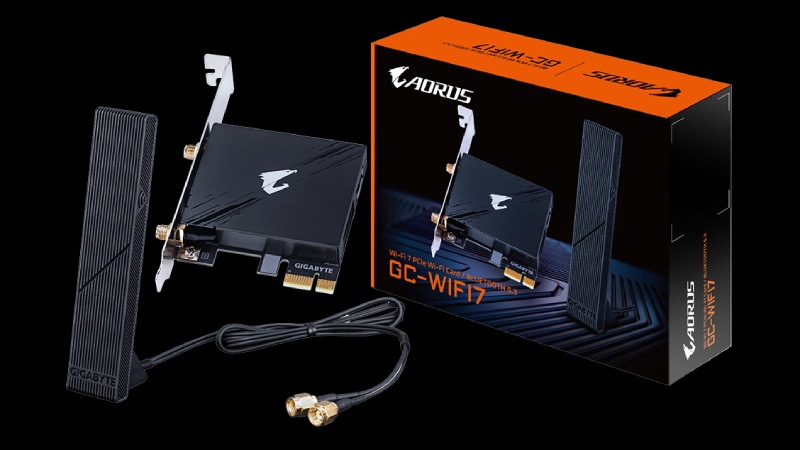Gigabyte is now selling a PCIe Wi-Fi 7 card called the GC-WIFI7 that is ideal for updating current and older desktop PCs to the newest wireless standard, in anticipation of the Wi-Fi 7 specification being finalized early next year.
The card has a PCIe x1 interface that connects to the motherboard and is packaged in a compact, half-height single-slot form factor. It has all of the main features that Wi-Fi 7 has, such as MU-MIMO, 4K-QAM, MRU, and MLO, which allow the card to simultaneously transmit and receive data on the 2.4GHz, 5GHz, and 6GHz bands. The maximum bandwidth rating is 5800Mbps. Additionally, the GC-WIFI7 has Bluetooth 5.3 connectivity, which allows it to be used to connect phones, audio equipment, wireless peripherals, and more.
The Wi-Fi card also includes an antenna, which is contained in a black plastic shroud that is magnetized. This antenna should be simple to manage and tuck away, particularly on surfaces made of steel or iron.
The next generation of wireless technology, Wi-Fi 7, is anticipated to replace Wi-Fi 6 and Wi-Fi 6E in 2024. The new standard makes use of several enhancements that, in theory, more than quadruple the bandwidth that Wi-Fi is capable of handling. Real-world Wi-Fi 7 capable home router speeds are reported by router manufacturers like Netgear to be in the multi-gigabyte per second range.
There exist multiple methods through which Wi-Fi 7 surpasses Wi-Fi 6/6E in terms of speed. One is by means of a function known as Multi-Link-Operation, or MLO, which we previously covered. This enables a Wi-Fi 7 compatible router to be reached by a client device using multiple wireless bands and channels at once. Wi-Fi 7 devices have expanded this feature so that devices can connect to all three bands that are supported, which include 2.4GHz, 5GHz, and the 6GHz band. Previously, wireless networks could only access up to two frequency bands at a time, such as 2.4GHz and 5GHz.
Two additional significant advancements are related to QAM and MU-MIMO. Wi-Fi 7 can support up to 16 spatial streams when using MU-MIMO, compared to 8 when using QAM (quadrature amplitude modulation), which can support up to 4000 spatial streams. Additionally, the maximum channel bandwidth has been increased from 160MHz to 320MHz. Wi-Fi 7 is now able to operate better on all three bands thanks to all of these improvements.
Although bare M.2 Wi-Fi 7 modules have started to appear at online retailers in recent weeks, Gigabyte’s new Wi-Fi 7 card is one of the first PCIe options we’ve seen. Although we didn’t have access to U.S. pricing at the time of writing, one thing is certain: Gigabyte’s card will be far less expensive than a brand-new, top-tier Wi-Fi 7 router.
